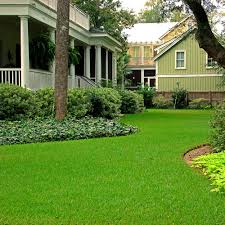St. Augustine Grass: The Ideal Warm-Season Turf
Discover the benefits of St. Augustine grass, or Stenotaphrum secans, for your landscaping needs. Learn how this lush, warm-season turfgrass thrives in warmer climates and enhances your outdoor spaces.
6/2/20255 min read


Introduction to St. Augustine Grass
St. Augustine grass, scientifically known as Stenotaphrum secans, is a warm-season turfgrass that is widely celebrated for its lush green appearance and ability to thrive in warmer climates. Originating from the tropical and subtropical regions of the world, this grass variety is particularly prevalent in the southern United States, where it has found a loyal following among homeowners and landscapers alike. Its adaptability to heat and high humidity, paired with its dense growth, makes it a favored choice for residential lawns and commercial landscapes in these areas.
One of the distinguishing characteristics of St. Augustine grass is its broad, flat blades, which create a thick carpet-like texture that enhances the aesthetic appeal of any lawn. This type of grass is not only visually appealing; it is also highly resilient against foot traffic, making it well-suited for gardens and recreational areas. Homeowners often choose St. Augustine grass for its rapid establishment and growth, allowing for quicker lawn development when compared to other grass types.
Furthermore, St. Augustine grass exhibits a notable tolerance to heat and drought conditions, which is particularly advantageous in southern regions where water conservation is often a pressing concern. Its ability to maintain its vibrant color and growth under stressful conditions reduces the need for excessive watering, thereby lowering maintenance efforts. Additionally, the grass's broad blades provide excellent shade coverage, which can inhibit weed growth—a crucial benefit for maintaining a healthy lawn.
Overall, the combination of aesthetic appeal, resilience, and low maintenance makes St. Augustine grass a popular choice among homeowners looking to cultivate a beautiful and sustainable lawn in warmer climates.
Growing St. Augustine Grass: Seed vs. Plugs vs. Sod
Establishing St. Augustine grass successfully in your lawn can be approached through three primary methods: seeds, plugs, and sod. Each method has its own advantages and disadvantages that should be carefully considered based on your specific circumstances and preferences.
Starting with seeds, it is important to note that St. Augustine grass is not commonly available in seed form, which makes this method less viable. However, hybrid seeds mimicking this variety exist, although they may require more maintenance and expertise. One of the major advantages of using seeds, when applicable, is the cost-effectiveness. Though direct seed planting can be a more affordable initial option, the results may not be as uniform or robust as other methods.
Plugs, on the other hand, are small sections of St. Augustine grass that are planted into the soil. This method allows for successful establishment at a lower cost than sod while still providing distinct patches of grass that can spread over time. The primary drawback is that plugs take longer to fill in bare areas compared to sod, requiring patience and consistent care. Plugs are particularly beneficial for smaller areas or for homeowners who enjoy a gradual improvement in their lawns.
Sod is often considered the most efficient method for establishing St. Augustine grass due to its ability to deliver instant results. By laying down large sections of pre-grown grass, homeowners can achieve a lush lawn within a short period. While the upfront costs may be higher, sod can ultimately save time and effort in establishing a healthy lawn. However, sod does require careful installation and immediate care to ensure proper rooting and establishment.
When choosing between these methods, factors such as budget, lawn size, and time availability must be considered. For smaller spaces and tighter budgets, plugs might be the ideal choice. For expansive areas requiring immediate coverage, sod may be the recommended route. Ultimately, your decision should align with your goals for lawn aesthetics and maintenance level.
Caring for St. Augustine Grass: Fertilization and Maintenance
Maintaining a healthy St. Augustine grass lawn requires a well-structured care regimen that emphasizes fertilization and maintenance. St. Augustine grass is a warm-season turf that thrives in subtropical climates, and providing it with the right nutrients is essential for encouraging lush growth and resilience against environmental stressors. Fertilization should ideally begin in the spring as temperatures rise. A balanced fertilizer, typically with a ratio of 16-4-8 or 15-5-10, ensures adequate nitrogen, phosphorus, and potassium, which are crucial for promoting root development and greenness.
In addition to using the right fertilizer, developing a schedule is vital to keep the grass healthy. Fertilize your St. Augustine grass every 6 to 8 weeks during the growing season, avoiding application in late autumn or winter when the grass enters dormancy. Moreover, following up with proper watering practices enhances the nutrient uptake from the soil. It is recommended to water deeply, applying around 1 inch of water per week, which can include rainfall. Watering early in the morning promotes efficient absorption without the risk of fungal diseases that moisture at cooler times can encourage.
Mowing is another critical aspect of St. Augustine grass care. The ideal mowing height is between 2.5 to 4 inches. Regular mowing not only keeps the lawn neat but also encourages thicker grass growth, helping to outcompete weeds. If pests or diseases occur, early identification and management are crucial. Implement integrated pest management (IPM) practices, which may include manual removal of pests, applying suitable insecticides, and ensuring proper lawn hygiene to minimize risks.
By following these essential guidelines for fertilization, watering, mowing, and pest control, homeowners can maintain a vibrant and resilient St. Augustine grass lawn that thrives through various seasonal challenges.
Finding St. Augustine Grass Products: Where to Buy and Options Available
When seeking St. Augustine grass products, several avenues exist for procuring quality seeds, plugs, and sod. Local suppliers, garden centers, and home improvement stores typically stock these materials, making them convenient options for those who prefer purchasing in person. It is advisable to visit stores during the growing season for the best selection. Engaging with local gardening communities or forums can provide recommendations for reputable suppliers who specialize in St. Augustine grass, ensuring you receive healthy and robust products.
For those who prefer online shopping, various retailers offer St. Augustine grass products, allowing customers to compare prices and product quality conveniently. Established online platforms such as Amazon, eBay, or specialty gardening sites often provide detailed descriptions, customer reviews, and competitive pricing for their offerings. Moreover, purchasing directly from manufacturers or local nurseries with online ordering capabilities can yield fresh and healthy grass options, which are critical for successful growth.
When selecting St. Augustine grass, buyers should consider the type of product best suited for their needs. Seeds are a cost-effective option, but may require more time and patience for establishment. Plugs provide an ideal balance, allowing for quicker coverage while still being economical. Alternatively, sod offers an instant lawn but can be pricier. Buyers should also assess the specific variety of St. Augustine grass available, as different types may vary in tolerance to heat, shade, and pests.
Ultimately, ensuring quality in your St. Augustine grass purchase involves evaluating the visual condition of the grass, understanding the delivery options, and confirming the credibility of the retailer. By following these guidelines, purchasing St. Augustine grass products can be an informed and satisfying experience, leading to a thriving lawn.
